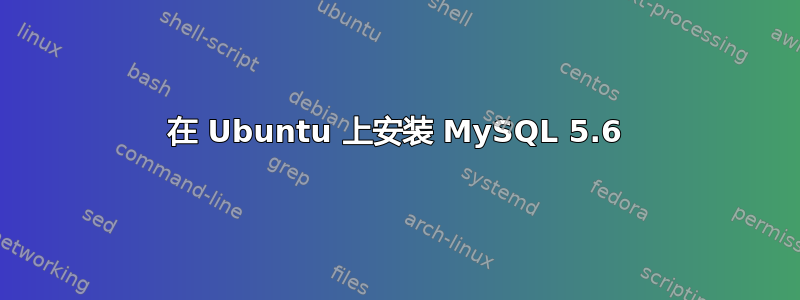
出于开发原因,我需要在我的 ubuntu 机器上安装 mysql 5.6(最新版本包含我需要合并到一些 web 项目中的功能)。但我遇到了一些问题。我一直在关注这个教程,它不是针对 5.6 版本的,但我认为它大致相同:http://www.ovaistariq.net/490/a-step-by-step-guide-to-upgrading-to-mysql-5-5/
我不确定我是否正确设置了 /etc/my.cnf 文件。以下是我所拥有的:
# Example MySQL config file for large systems.
#
# This is for a large system with memory = 512M where the system runs mainly
# MySQL.
#
# MySQL programs look for option files in a set of
# locations which depend on the deployment platform.
# You can copy this option file to one of those
# locations. For information about these locations, see:
# http://dev.mysql.com/doc/mysql/en/option-files.html
#
# In this file, you can use all long options that a program supports.
# If you want to know which options a program supports, run the program
# with the "--help" option.
# The following options will be passed to all MySQL clients
[client]
#password = your_password
port = 3306
socket = /var/run/mysqld/mysqld.sock
# Here follows entries for some specific programs
# The MySQL server
[mysqld]
port = 3306
socket = /var/run/mysqld/mysqld.sock
skip-external-locking
key_buffer_size = 256M
max_allowed_packet = 1M
table_open_cache = 256
sort_buffer_size = 1M
read_buffer_size = 1M
read_rnd_buffer_size = 4M
myisam_sort_buffer_size = 64M
thread_cache_size = 8
query_cache_size= 16M
pid_file = /usr/local/mysql/data/dev.pid
basedir = /usr/local/mysql
datadir = /usr/local/mysql/data
tmpdir = /tmp
log_error = /var/log/mysql/error.log
user = mysql
# Try number of CPU's*2 for thread_concurrency
thread_concurrency = 8
# Don't listen on a TCP/IP port at all. This can be a security enhancement,
# if all processes that need to connect to mysqld run on the same host.
# All interaction with mysqld must be made via Unix sockets or named pipes.
# Note that using this option without enabling named pipes on Windows
# (via the "enable-named-pipe" option) will render mysqld useless!
#
#skip-networking
# Replication Master Server (default)
# binary logging is required for replication
log-bin=mysql-bin
# binary logging format - mixed recommended
binlog_format=mixed
# required unique id between 1 and 2^32 - 1
# defaults to 1 if master-host is not set
# but will not function as a master if omitted
server-id = 1
# Replication Slave (comment out master section to use this)
#
# To configure this host as a replication slave, you can choose between
# two methods :
#
# 1) Use the CHANGE MASTER TO command (fully described in our manual) -
# the syntax is:
#
# CHANGE MASTER TO MASTER_HOST=<host>, MASTER_PORT=<port>,
# MASTER_USER=<user>, MASTER_PASSWORD=<password> ;
#
# where you replace <host>, <user>, <password> by quoted strings and
# <port> by the master's port number (3306 by default).
#
# Example:
#
# CHANGE MASTER TO MASTER_HOST='125.564.12.1', MASTER_PORT=3306,
# MASTER_USER='joe', MASTER_PASSWORD='secret';
#
# OR
#
# 2) Set the variables below. However, in case you choose this method, then
# start replication for the first time (even unsuccessfully, for example
# if you mistyped the password in master-password and the slave fails to
# connect), the slave will create a master.info file, and any later
# change in this file to the variables' values below will be ignored and
# overridden by the content of the master.info file, unless you shutdown
# the slave server, delete master.info and restart the slaver server.
# For that reason, you may want to leave the lines below untouched
# (commented) and instead use CHANGE MASTER TO (see above)
#
# required unique id between 2 and 2^32 - 1
# (and different from the master)
# defaults to 2 if master-host is set
# but will not function as a slave if omitted
#server-id = 2
#
# The replication master for this slave - required
#master-host = <hostname>
#
# The username the slave will use for authentication when connecting
# to the master - required
#master-user = <username>
#
# The password the slave will authenticate with when connecting to
# the master - required
#master-password = <password>
#
# The port the master is listening on.
# optional - defaults to 3306
#master-port = <port>
#
# binary logging - not required for slaves, but recommended
#log-bin=mysql-bin
# Uncomment the following if you are using InnoDB tables
#innodb_data_home_dir = /usr/local/mysql/data
#innodb_data_file_path = ibdata1:10M:autoextend
#innodb_log_group_home_dir = /usr/local/mysql/data
# You can set .._buffer_pool_size up to 50 - 80 %
# of RAM but beware of setting memory usage too high
#innodb_buffer_pool_size = 256M
#innodb_additional_mem_pool_size = 20M
# Set .._log_file_size to 25 % of buffer pool size
#innodb_log_file_size = 64M
#innodb_log_buffer_size = 8M
#innodb_flush_log_at_trx_commit = 1
#innodb_lock_wait_timeout = 50
[mysqldump]
quick
max_allowed_packet = 16M
[mysql]
no-auto-rehash
# Remove the next comment character if you are not familiar with SQL
#safe-updates
[myisamchk]
key_buffer_size = 128M
sort_buffer_size = 128M
read_buffer = 2M
write_buffer = 2M
[mysqlhotcopy]
interactive-timeout
当我尝试奔跑
mysqld --skip-grant-tables --user=mysql
我收到此错误:
The program 'mysqld' can be found in the following packages:
* mysql-server-core-5.1
* mysql-cluster-server-5.1
Try: sudo apt-get install <selected package>
当我尝试停止服务器时,出现以下信息:
* MySQL server PID file could not be found!
当我尝试开始时:
Starting MySQL
.. * The server quit without updating PID file (/usr/local/mysql/data/dev.pid).
我假设我没有正确编辑 my.cnf 文件,但我完全迷失了。除此之外,我完全按照说明操作,并确保之前的 mysql 5.1 版本已从系统完全删除。
答案1
对于mysqld错误,您可能需要确保二进制文件位于您的 $PATH 中。尝试使用 进行检查which mysqld。
如果它不在你的路径上,你应该将它添加到你的配置文件中(如果你使用 bash,它可能是~/.bash_profile):
export PATH=/path/to/mysql/bin:$PATH
至于 PID 错误,您可以检查/var/log/mysql/error.log它是否为您提供了有关错误的任何提示,但我觉得可能是运行 MySQL 服务器的用户没有写入 PID 文件的权限,因此请确保它归该用户所有mysql(或您的发行版的等效文件)。
答案2
问题听起来像是您在 mysql 安装中使用了错误的 PATH 变量。也许可以尝试使用 mysqld-binary 的完整路径。
我还写了一篇关于如何升级 ubuntu 12.04 附带的 mysql 的文章。请查看http://www.peterchen.net/2013/02/20/en-how-to-install-mysql-5-6-on-ubuntu-12-04-precise/。希望这对您有所帮助,因为它涵盖的是 mysql 5.6,而不是旧的 mysql 5.5。
答案3
我不认为自己是 MySQL 服务器管理员超级英雄,但我认为 @bhamby 说得对。似乎你部分安装了某个版本的 MySQL,结果以某种方式破坏了你正在运行的上一个版本。
另外值得注意的是:http://dev.mysql.com/doc/refman/5.6/en/upgrading.html
MySQL 建议您在主要发布版本之间进行“增量更新”:即从 MySQL 5.1 到 5.5,从 5.5 到 5.6,从 5.6 到 5.7,(等等?)
如果您是从全新安装开始,并且尚未启动或移植另一个预先存在的数据库,那么这显然不是必需的,但就故障排除问题而言,这似乎与帖子相关,因为似乎您试图从 5.1 跳到 5.6,而不是先转到 5.5。
你的 my.cnf 文件看起来没什么特别,但是你可能当前数据和日志文件存在问题,需要清除。我通常先停止 MySQL 服务器,然后在升级或更改日志文件大小时删除它们。
我相信这些通常位于 Ubuntu 的“/var/lib/mysql/”中(但不要引用我的话):
ibdata1
ib_logfile0
ib_logfile1
经过几个小时的摆弄(和一些图像恢复)后,我发现了一个非常简单的逐步过程,可以在运行 Ubuntu 14.03 的 DO 云托管 VM 上将 MySQL 5.5 升级到 5.6,这对于运行 15.04 和 15.10 的本地 VirtualBox VM 也运行良好。
我按照本指南为使用全新 Ubuntu 14 或 15 安装(通常附带 MySQL 5.5“开箱即用”)的用户制作了一个超级简单的“只需复制/粘贴 CLI 命令”指南。升级到 MySQL 5.7 的过程非常相似,但更新 APT 存储库 MySQL 默认值以使用 MySQL 5.7 与以前的版本略有不同。我希望这可以帮助其他在升级 MySQL 版本时遇到类似问题的人。


